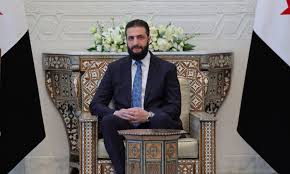As relations between Damascus and Washington continue to evolve following the fall of the Assad regime, a confidential list of American demands has surfaced, outlining the key conditions for lifting sanctions and restoring bilateral cooperation. The demands, described as “confidence-building measures,” reflect Washington’s desire to test the seriousness of Syria’s new leadership under President Ahmad al-Sharaa, while linking economic relief to measurable security and political outcomes.
This information was first published by Al-Majalla, which reviewed a document delivered by U.S. diplomat Natasha Franceschi to Syrian Foreign Minister Assad al-Shibani during a meeting in Brussels last March. The document, jointly drafted by representatives of the outgoing and incoming U.S. administrations, contains eight primary demands:
- The formation of a professional, unified Syrian army with no foreign fighters in key command roles.
- Full access to all chemical weapons facilities and associated infrastructure.
- The establishment of a committee to investigate the fate of missing Americans, including journalist Austin Tice.
- The repatriation of ISIS family members currently detained at the Al-Hol camp, under the control of the Syrian Democratic Forces (SDF).
- Sustained cooperation with the U.S.-led international coalition in the fight against ISIS.
- Authorization for the United States to conduct counterterrorism operations on Syrian territory targeting individuals it deems threats to national security.
- A public declaration banning all Palestinian militias and political activities in Syria, accompanied by the deportation of their members in a bid to address Israeli security concerns.
- A commitment to preventing Iranian military entrenchment in Syria and formally designating the Islamic Revolutionary Guard Corps (IRGC) as a terrorist organization.
While the document covers wide-ranging security issues, it notably omits concrete demands for the establishment of a transitional government, constitutional reform, or implementation of transitional justice. These issues appear only in annexes and are not considered binding conditions.
In exchange for compliance, Washington has proposed the extension of existing sanctions exemptions, set to expire in July, and signalled the possibility that President Donald Trump may issue an executive order suspending the Caesar Act. The act, a cornerstone of U.S. economic pressure on Syria, is widely regarded as a major impediment to the country’s reconstruction and access to foreign aid.
Damascus Responds: Careful Cooperation, Firm Reservations
The Syrian government’s initial reaction was one of disappointment. Officials in Damascus viewed several of the proposed measures as infringements on national sovereignty, particularly the constraints on Palestinian political activity, the targeting of specific individuals, and the prospect of U.S. military freedom of operation within Syrian borders.
Nonetheless, the Syrian Foreign Ministry submitted a formal written response to Washington last week. While expressing reservations about specific provisions, the response also outlined steps already taken by Damascus in areas aligned with U.S. concerns. American officials are currently evaluating the reply.
Progress appears most tangible on the chemical weapons front. In February, President al-Sharaa hosted a delegation from the Organisation for the Prohibition of Chemical Weapons (OPCW), led by Director-General Fernando Arias, in what was the organisation’s first official visit to Damascus since the fall of Assad. Arias welcomed the engagement as a “new beginning,” and suggested the visit could lead to a final resolution of Syria’s long-standing chemical weapons file. The OPCW has identified more than 100 additional sites potentially linked to the programme, discovered after Assad’s removal.
Damascus has also moved to restrict the activities of armed Palestinian factions, intensify its efforts against ISIS, and enhance coordination with the U.S.-backed SDF. In a significant breakthrough, President al-Sharaa signed an agreement with SDF commander Mazloum Abdi, who visited Damascus twice aboard U.S. helicopters. The agreement, based on a joint “paper of principles” signed on 10 March, has already begun to materialise through a series of practical steps.
As part of this evolving security landscape, the U.S. Department of Defence has announced plans to reduce its troop presence in Syria to fewer than 1,000. The New York Times recently reported that hundreds of American soldiers have begun withdrawing from the country’s north, and that three of the eight existing military bases are slated for closure.
This military drawdown coincides with a ceasefire between the SDF and Turkish forces in northeastern Syria, reflecting a broader recalibration of U.S. engagement in the region and underscoring the fragile but potentially transformative nature of the new arrangement between Washington and Damascus.
A Fragile Opening at Risk of Collapse
However, the path ahead remains uncertain. While Damascus has taken notable steps to align with parts of the American demands, its reservations—particularly regarding U.S. military operations on Syrian soil and the political ban on Palestinian factions—signal a potential impasse. If these sticking points persist, they could place the new Syrian government at odds with Washington and cast a shadow over the fragile thaw in relations.
Moreover, any perceived reluctance by Damascus to fully comply with the conditions may complicate ongoing discussions over sanctions relief, including the potential suspension of the Caesar Act. It could also strain the nascent partnership with the Syrian Democratic Forces, whose cooperation has been central to both the counter-ISIS campaign and recent American policy in the region.
What began as a tentative opportunity for re-engagement now stands at a critical juncture, with the risk that mutual hesitations could stall or even reverse the early momentum.


